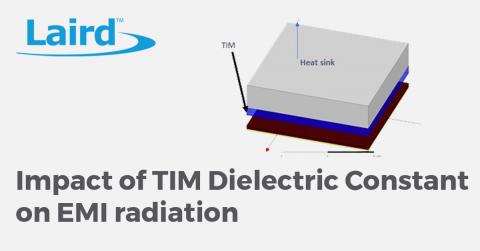
CLEVELAND, Ohio -- June 23, 2020 -- Laird Performance Materials, a leading global supplier of thermal interface materials used in effectively transferring heat away from sensitive electronics, today published a paper discussing the effect of the thermal material’s dielectric constant in applications of different frequency ranges.
In the paper, Impact of TIM Dielectric Constant on EMI Radiation, Laird staff scientist Paul Dixon shares his analysis and notes that the findings suggest design engineers who utilize low dK thermal interface materials (TIMs) can ensure that the electromagnetic interference radiation (EMI) produced by the system will not increase.
Laird is one of the few global companies with extensive experience working with electronic component manufacturers to understand and resolve both heat load and EMI mitigation issues. Each can hinder design development. When both issues can arise simultaneously, new challenges are created.
The company adopts a unique system level approach in addressing thermal and EMI interactions, how they can affect components and how to resolve issues. Advanced system modeling and simulation as well as other multifunctional materials help mitigate EMI and thermal design concerns. As part of this approach, Mr. Dixon’s paper examines the performance of low dK thermal materials at higher frequencies and cites Laird solutions.
Integrated circuits (IC) are common EMI sources in many systems. ICs also generate thermal energy which must be efficiently removed from the system, typically via a heat sink. To enable effective thermal transfer, a thermal interface Material (TIM) is often positioned between the IC and a heat sink. Common desirable qualities of a TIM include high thermal conductivity, and softness of the material itself, to ensure contact between the IC, heatsink and TIM.
The paper notes that in many cases, the dielectric constant is irrelevant to the performance of the overall system. However, as operational frequencies increase into the microwave/millimeter wave band, it has been found that the dielectric constant of the TIM can cause an unacceptable increase in EMI radiation.
An added amount of EMI radiation can be pivotal to design success. The inability to effectively mitigate EMI can lead to failure in regulatory compliance or deterioration in operating efficiency of the device. Ever growing design density and complexity adds to EMI noise. To overcome these potential barriers, there is a need for TIM materials with a low dielectric constant (dk).
About Laird Performance Materials
Laird Performance Materials, a portfolio company of Advent International, enables high-performance electronics. We create advanced protection solutions for electronic components and systems. World-leading technology brands rely on us for improved protection, higher performance and reliability, custom structural designs and faster time-to-market. We solve design issues through innovative products such as EMI suppression or absorption materials, thermal interface materials, structural and precision metals, magnetic ceramic products and multi-functional solutions. This latter product family solves multiple EMI, thermal and structural design issues simultaneously using a single process design. Visit https://www.laird.com